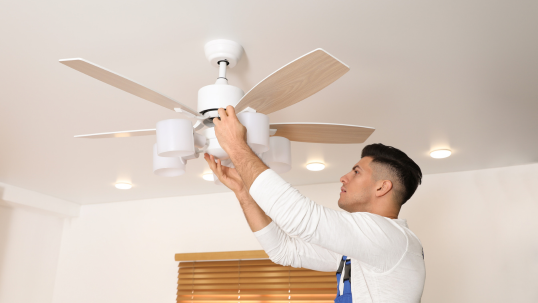Ceiling Fan Sizes, Maintenance, and More
There are many ways to improve comfort and lower energy consumption at home, yet few are as simple or as stylish as the ceiling fan. New ceiling fan installations are skyrocketing in Myrtle Beach as more homeowners look to keep heating and cooling bills in check. In our guide, you’ll learn how to size and maintain a ceiling fan for any room in your home.
How to Size a Ceiling Fan (and Why It Matters)
Choosing the correct size ceiling fan ensures efficiency and adequate air circulation for the desired space. You can usually base your ceiling fan sizing choice on fan diameter and room space.
Check out these recommendations based on room size from ENERGY STAR:
- Small rooms, or less than 100 square feet: 29- to 36-inch diameter
- Medium-to-large rooms up to 400 square feet: 36- to 50-inch diameter
- Large rooms over 400 square feet: 50- to 70-inch diameter
When a Ceiling Fan Is Too Small (or Too Big)
If you’re on the fence between ceiling fan sizes, it’s usually best to opt for the smaller option for a couple of reasons. First, a ceiling fan that is too big may be visually or physically overwhelming and inefficient. Plus, your fan might make your home feel like a whirlwind if it’s too powerful! Of course, choosing a ceiling fan that is too small won’t circulate air efficiently, limiting its effectiveness.
Your Swift Services technician will help determine your space's ideal ceiling fan size.
Common Types of Ceiling Fans
There are several types of ceiling fans to choose from based on mounting style, materials, and overall aesthetic. Two of the most popular options are standard/downrod mount ceiling fans and flush mount ceiling fans. The best type of ceiling fan for your room depends on your needs and aesthetics.
Standard/Downrod Mount Ceiling Fans
This is the most common type of fan found in homes. This type of ceiling fan hangs from a downrod, which positions the fan away from the ceiling to optimize airflow. The length of the downrod is adjustable on most models.
Flush Mount Ceiling Fans
Ideal for rooms with low ceilings, flush mount ceiling fans install directly against the ceiling to maximize headroom.
Ceiling Fan Aesthetics
Stylistically, ceiling fans are usually categorized as traditional, modern, rustic, or industrial. Ceiling fans are versatile because they can be the centerpiece of a space with bold styling, or a neutral component with muted colors.
Once you’ve found the perfect fit, let us handle the hard part. For ceiling fan wiring and installation support in Myrtle Beach, contact our experienced team today!

Your Ceiling Fan Maintenance Checklist
Do ceiling fans need maintenance? The short answer is yes, but much of the work is quick and easy. Following these tips can help avoid unexpected issues and ceiling fan repairs.
Always turn off the fan before cleaning or adjusting your fan—safety first!
Read more: Tips for Home Energy Efficiency
Clean Your Ceiling Fan: Every 1-3 Months
Wipe down your ceiling fan blades to prevent dust buildup. Try using a microfiber cloth or a pillowcase; this lets you trap dust in the pillowcase, avoiding a mess on the floor.
Take a moment to dust the light fixture and bulb if your fan has one.
Semi-Annual Tune-Ups: Every 6-12 Months
Depending on how often you use your fan, consider giving it a quick tune-up every spring or fall when you change your ceiling fan’s direction.
- Tighten all screws on the fan blades, motor housing, and mounting bracket.
- Visually inspect the ceiling fan wiring for signs of damage or exposure.
- Replace the batteries in the wireless remote (if it’s been a while).
- Lubricate, if necessary. Older fans have oil ports and usually call for non-detergent oils like SAE 10W or SAE 20W. New fans do not require lubrication. Since there are many different types of ceiling fans, check your owner’s manual for model-specific instructions.
What Direction Should a Ceiling Fan Go In the Summer?
Get the most out of your ceiling fan by changing its rotation direction seasonally. Most units have a simple toggle switch to change direction, though some require a screwdriver.
- The ceiling fan direction for summer is counterclockwise. A counterclockwise-spinning fan pushes air downwards, creating a cool breeze and enhancing your home’s natural airflow.
- The ceiling fan direction for winter is clockwise. Warm air rises, which means heat tends to gather near the ceiling. A clockwise-spinning fan pulls cooler air up, forcing warm air down along the walls and back into the center of the room.
Trust the Ceiling Fans Experts in Myrtle Beach
From sizing and selection to wiring a ceiling fan, we’re the Myrtle Beach area’s go-to source for expert ceiling fan services. Our experienced technicians will keep your fan spinning for years to come. Count on Swift Services for all your home service needs!
Book an appointment or call 843-352-6427 for prompt and professional service!

